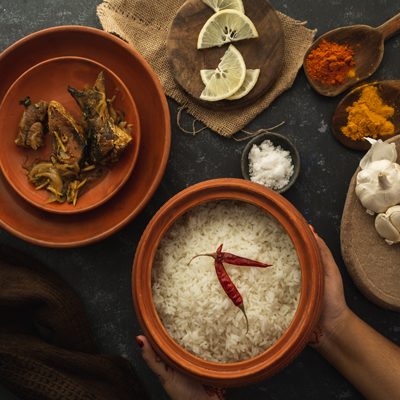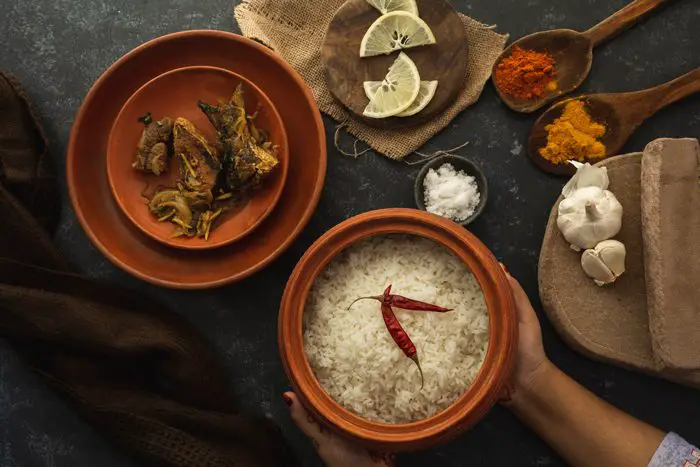Regional Specialities of Bangladeshi Cuisine
Bangladeshi cuisine boasts a rich diversity of flavors and ingredients, influenced by its history, geography, and cultural traditions. The staple foods are rice and fish, reflecting the country’s river-lined landscape. This cuisine combines elements from the Indian subcontinent and Persian-influenced Mughlai cuisine, resulting in a unique blend of flavors and techniques.
The cuisine’s defining features include its use of healing spices, proteins from various sources, and fresh seasonal vegetables. Mustard oil is a traditional cooking oil, and the “Panch phoron” spice mix adds a distinctive taste to many dishes. The ingredients used in Bengali cooking are unlike any others. Every meal is packed with protein and healthy seasonings, and the dishes manage to keep most of their fiber content. The cuisine aligns with Muslim dietary practices, emphasizing halal preparation and consumption of meats and seafood while avoiding pork.
Bengali cuisine is unique in the ingredients it has. The dishes retain much of the fiber and a lot of proteins are eaten in every meal cooked with healing spices.
Bangladeshi cuisine is aligned with the nation’s six distinct seasons, with shifting preferences for certain dishes based on the time of year. Traditional breakfasts might include fried puffy bread (“Luchi“) with mixed vegetables and lentils, often accompanied by tea (“Cha“). Unique breakfast options like “Panta bhat” use fermented rice leftover from dinner and are considered refreshing, especially during the summer.
Lunch and dinner typically consist of rice with fish or meat curries, lentils, and vegetables. Hilsa curry, featuring the marinated and pan-fried Hilsa fish in a mustard gravy, is a national delicacy. The cuisine also makes use of all parts of the fish in various dishes. “Dhokar Dalna,” a signature dish, features fried lentil cakes simmered in a tomato and potato gravy, omitting the use of onions and garlic.
“Cha Nasta” is a midafternoon/early evening tradition akin to British high tea, where sweet and savory fried snacks like fritters are enjoyed alongside tea. Similar to Indian samosas, Bangladeshi “Singara” and samosas are filled with vegetable and cabbage mixtures, with variations in crust texture.
Dairy-based desserts are popular, featuring items like “Rashmalai,” sweetened paneer balls in clotted cream, and “Mishti doi,” a fermented sweet yogurt prepared in earthenware containers. Other sweet treats include “Shir-e-faluda,” a vermicelli pudding, and “Shir berenj,” sweetened rice flavored with spices and rosewater.
In a nutshell, the culinary landscape of Bangladesh exhibits a notable degree of diversity. While the majority of dishes share common ingredients, the Bengali cuisine boasts a wide array of regional variations, each distinguished by its own distinctive and refined addition that will enhance your dining experience. The prevalence of this diversity becomes particularly evident when one travels to various regions of the country in order to try out the iconic regional dishes that are prepared with utmost authenticity.
Regional specialities:
In this blog, we will explore the unique regional characteristics of Bangladesh, traditionally divided into four distinct regions. These regions include Northern Bengal, encompassing Rajshahi and Rangpur Divisions; Eastern Bengal, which comprises Chittagong, Sylhet, and the proposed Comilla Division, renowned for the Surma-Meghna River System; Central Bengal, consisting of Mymensingh and Dhaka Divisions, excluding the proposed Faridpur Division; and Southern Bengal, which includes Barisal, Khulna, and the proposed Faridpur Division.
1. Northern Bengal:
Northern Bangladesh, encompassing the Rangpur and Rajshahi Divisions, is known for its thriving dairy farms and unique culinary specialities. The region is celebrated for its delicious Sweets and Yogurt (doi), while Biral Upazila is famous for Koi fish cooked in banana leaves. Bogra is renowned for its Sweet curds, and Rangpur offers a beef and pumpkin dish. In the Rajshahi Division, the Santal people have distinct culinary traditions, including Crab, Pork, Squirrel, and Fish dishes with fewer spices, along with homemade alcoholic beverages like Hadia. Various areas within these divisions have their own culinary highlights, such as Shigonjer Chomchom, Kolaiyer Ruti, Sondesh, Panitoa, Chamcham, and Rashmalai, adding to the region’s diverse and flavorful cuisine.
2. Eastern Bengal:
The Eastern Bengal region, comprising Chittagong, Sylhet, and the proposed Comilla Division, offers a diverse culinary landscape. In the Chittagong Division, highly spiced curries are prevalent, with beef being a common ingredient. Special dishes like Mejbani gosht are reserved for special occasions, often enjoyed during communal feasts known as Mejban or Mezban. While beef dishes are popular among Bengali Muslims, the Hindu community in Chittagong prefers fish-based preparations. Noteworthy dishes include Kala bhuna (blackened beef), Durus kura (whole chicken cooked in thick broth), and Akhni (Orosher Biriyani). The coastal location of Chittagong results in a seafood-rich cuisine featuring fish like rupchanda and Loitta, along with unique delicacies like Shutki. The Chittagong Hill Tracts, home to indigenous tribes, have their own cuisine characterized by herbs from the hills, Fermented shrimp and Fish, Wild mushrooms, and unique cooking methods like Bamboo and Banana leaf cooking. In the Sylhet Division, characteristic ingredients like Shatkora/Hatkora and Thoikor are commonly used in fish and meat dishes. Notable dishes include Akhni, Birin rice, Khichuri, Beef Hatkhora, Aash Bash, and various fish preparations incorporating shutki and hatkora. The region also offers traditional rice cakes like Chunga Pitha, snacks like Bakarkhani and Handesh, and delightful desserts like Tusha Shinni and Seven Color Tea.
3. Central Bengal:
Central Bengal, encompassing the Mymensingh and Dhaka Divisions, presents a diverse culinary tapestry influenced by Mughlai, Central Asian, Armenian, Hindustani, and native Bengali cuisines. Dhaka, the capital city, particularly embodies this culinary fusion. Mughlai cuisine, introduced by the Nawabs of Dhaka, features extravagant dishes often incorporating meat, dairy ingredients like lamb, mutton, beef, and yogurt, and mild spices. Specialties include Kebabs, Stuffed Breads, Kacchi Biryani, Roast Lamb, Duck, and Chicken, Patisapta, Kashmiri tea, and Korma, cherished during festive occasions like Eid and weddings. Dhaka’s Chowk Bazaar, a centuries-old market, buzzes during Ramadan, serving the Iftar meal. Dhakaiya Paratha, a multi-layered bread, gained fame in Kolkata following the Partition of India. Noteworthy dishes in Dhaka include Haji biryani, Bakarkhani, and Morog Pulao. The region also boasts various local specialties like Rasogolla in Gopalganj, Balish Misti in Kishoreganj, Bibikhan Pitha in Shariatpur, Rashmalai in Narayanganj, Khejur gur in Manikganj, Vagyokuler Misti in Munshiganj, Chanar Payesh, Chanar Chop in Sherpur, Chanar Polau, Chanar Payes, Rashmalai in Jamalpur, Muktagachar Monda in Mymensingh, and Balish Misti in Netrokona.
4. Southern Bengal:
Southern Bengal, encompassing Barisal, Khulna, and the proposed Faridpur Division, boasts a distinctive culinary identity. The region is characterized by the use of Piper chaba, a fiery aromatic spice predating the introduction of chili from the Americas in the 16th century, which is added to meat and fish dishes. Barisal, located along the coast, incorporates coconut into its cuisine, adding a unique tropical flavor. Specific culinary highlights within this region include Buffalo Yogurt in Patuakhali and Bhola, Chuia Pitha, Chaba Pitha, Mutta Pitha, and Allan biski in Barguna (Barisal Division), Sabitri Mishti and Raskadambo in Meherpur, Khoi, Khejurgur, and Jamtolar Mishti in Jessore, Kulfi and Tiler khaja in Kushtia, Rashmalai in Magura, Khejurer Ros, Para sondesh, and Khejurer gur in Narail, and Sondesh in Satkhira (Khulna Division). Additionally, Faridpur (proposed division) is known for its Khejur gur, adding to the rich and diverse culinary heritage of Southern Bengal.




